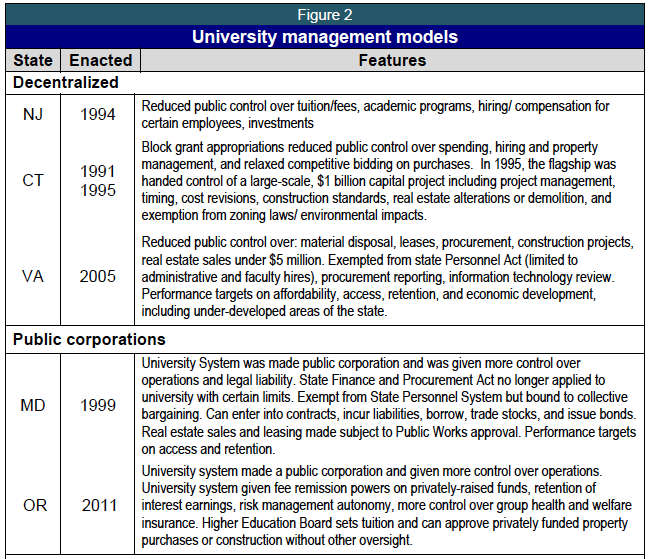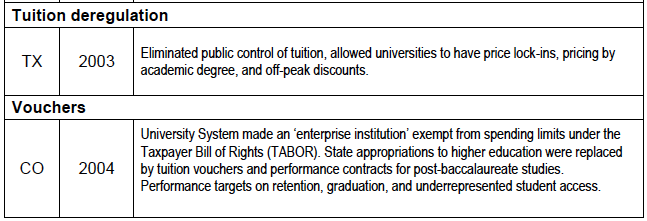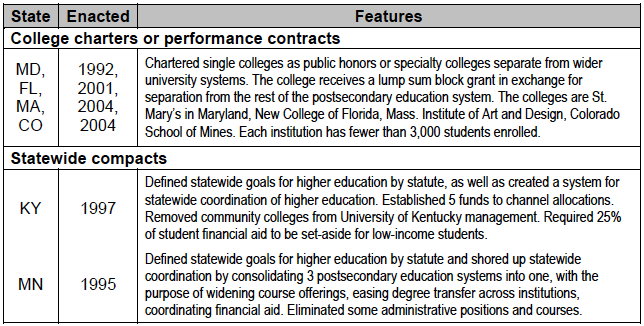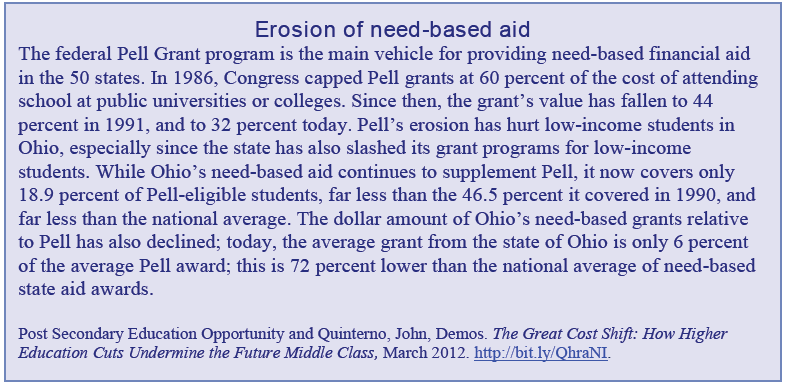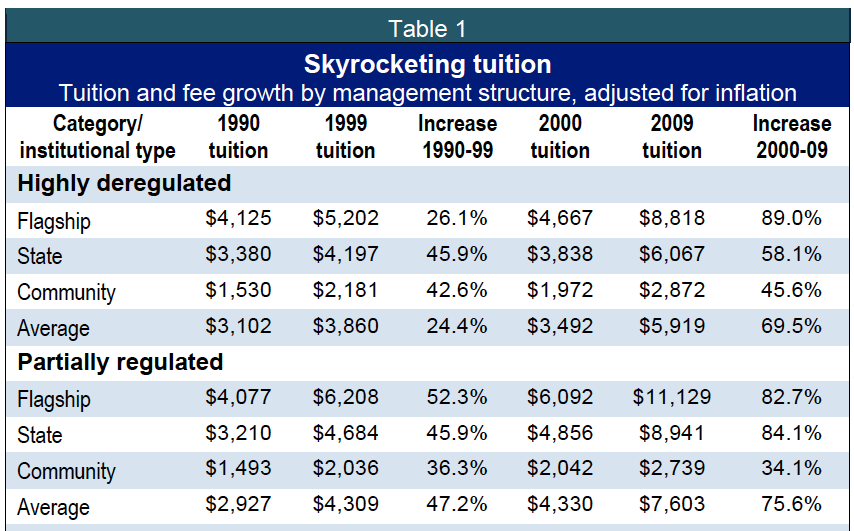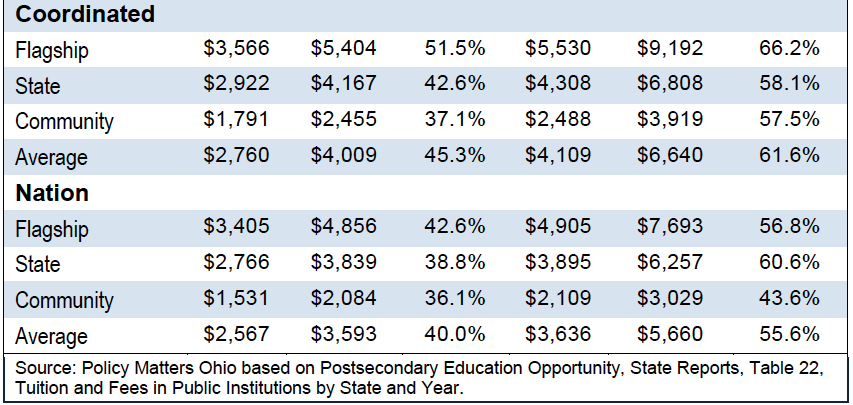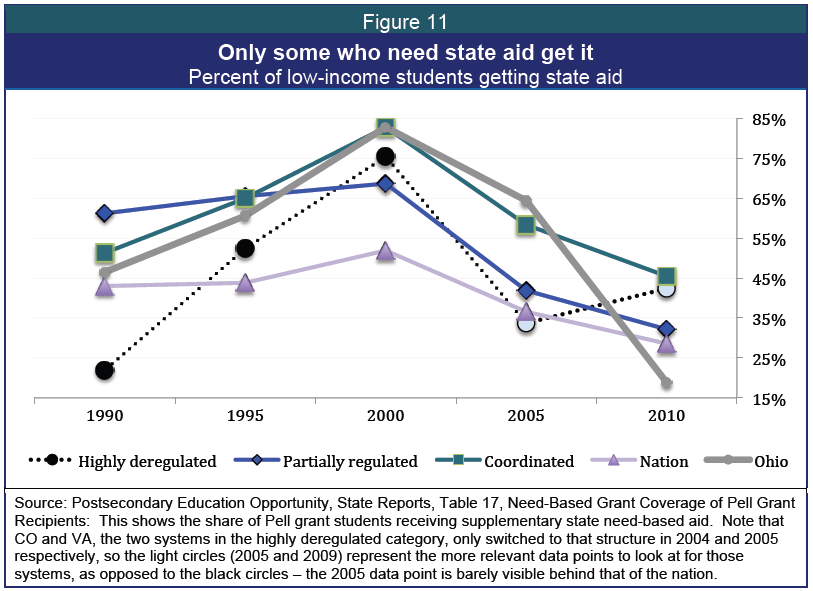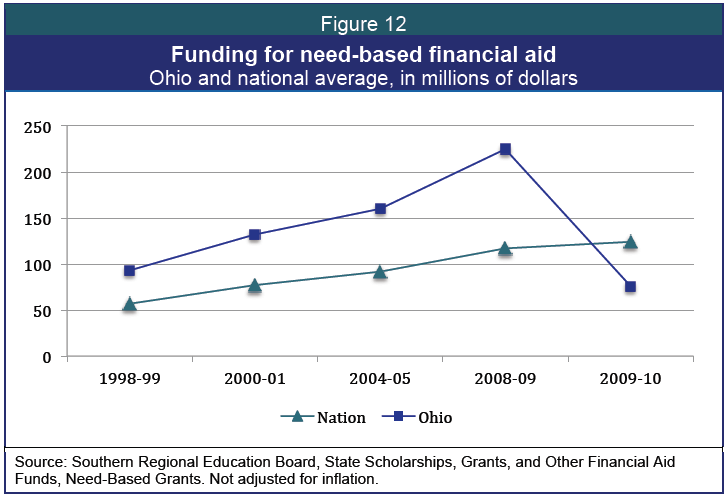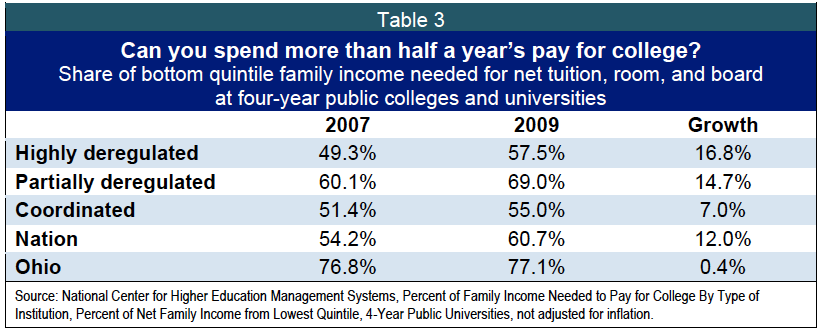
Deregulation and higher education
October 17, 2012
Deregulation and higher education
October 17, 2012
Download reportDownload executive summaryPress releaseDeregulation in other states has not made tuition more affordable, increased access for low-income students, or increased graduation rates. Public support for universities and funding for need-based aid, not management structure, are the key factors that lead to lower tuition and more access.
Potential impact on access, affordability and achievement in Ohio
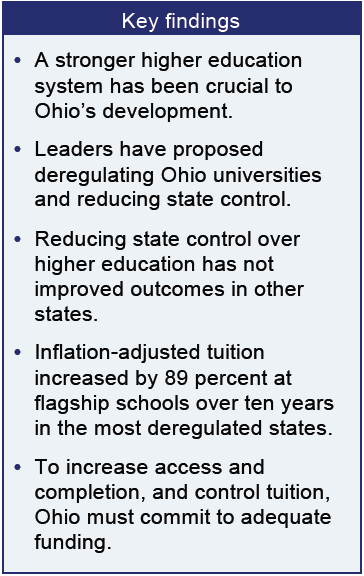 Prosperous regions are educated regions. Ohio’s relatively low share of residents with college degrees has concerned one governor after the other and proposals for managing our university system have differed substantially. The Kasich administration’s higher education proposal, the Enterprise University Plan for Ohio, is likely to form the basis for education proposals going forward.[1] The proposal advocates for the creation of “enterprise universities” that receive, among other things:
Prosperous regions are educated regions. Ohio’s relatively low share of residents with college degrees has concerned one governor after the other and proposals for managing our university system have differed substantially. The Kasich administration’s higher education proposal, the Enterprise University Plan for Ohio, is likely to form the basis for education proposals going forward.[1] The proposal advocates for the creation of “enterprise universities” that receive, among other things:
- Broad exemption from state fiscal and administrative statutes;
- Diminished state oversight of real estate, construction, procurement, and legal settlements;
- Elimination of student enrollment caps;
- Authority to set differential tuition.
This proposal, like similar models in other states, is based on the idea that (1) cost savings ensue from deregulation of university management, (2) university administrators respond to these hypothetical savings by committing to expanding college enrollment and graduation, tuition affordability, and closing higher education gaps, and (3) such commitments can reverse or alter decades of performance. This paper examines different educational management models to assess the validity of those assumptions.
We want to make clear at the outset that the most important factor in access, enrollment, completion, tuition cost and affordability for low and moderate-income students is not management structure. On the contrary, the way to increase enrollment and completion, particularly for those from modest backgrounds, is to provide high levels of funding to higher education and target it to need-based aid. However, because deregulation has been presented as a model for Ohio, this paper examines how deregulation has correlated with access, achievement and affordability in other states.
Our analysis suggests that deregulation does not increase college completion, make college affordable, or close the higher education gap. In many cases, deregulated states seem to perform worse than the nation on many indicators of accessible and affordable higher education.
This paper refocuses attention on the importance of supporting Ohio students. States may appreciate deregulated higher education because, like other forms of privatization, it reduces support, responsibility and oversight. University administrations may see opportunities to raise revenues through real estate deals, parking arrangements, subcontracting, reducing staff compensation, and changing other employment relationships. Private contractors and the business community may favor these arrangements because there are lucrative possibilities for contracts, real estate deals and other arrangements. But the point of the system is not to serve the needs of legislators, administrators or contractors – it is to educate students. Students, families, employers and taxpayers need a vibrant higher education system capable of delivering affordable academic programs that connect to the 21st century economy.
The higher education challenge
Public universities and colleges in Ohio helped to dramatically increase higher education levels over the twentieth century. They have given Ohio employers skilled professionals, provided a pathway to the middle class for Ohio students, and provided Ohio businesses with cutting-edge research. They are a crucial public institution that has greatly enriched the state and will only increase in importance in the coming decades. With economic change, employers, individuals, and state governments increasingly look to colleges and universities to create a pathway from high school to work across many occupations and fields.[2] Ohio and the United States more generally have seen stark drops in job quality and job availability for students with just a high school degree. Such shifts have meant that higher education is becoming a prerequisite for even a modest middle class occupation.
However, Ohio’s universities face substantial challenges:
- Our higher education attainment rate is low. In 2010, just 26.7 percent of Ohio adults had at least a bachelor’s degree, compared to 29.9 percent of in the United States, ranking us 34th among states.[3] Demand for higher education is growing: 32 percent more students enrolled in Ohio’s public colleges and universities in 2010 than in 1990. Unfortunately, this growth was lower than the nation as a whole, where enrollments grew by 52 percent in the same period.[4] A growing percentage of jobs with middle-class compensation require some college.[5] By 2018, the Board of Regents argues that 57 percent of Ohio jobs will require a college degree or coursework.[6] Expanding higher education attainment requires attracting new student populations, especially those that have been under-represented in higher education traditionally. Chancellor Jim Petro, like Chancellor Eric Fingerhut before him, sets growth in college graduation rates as a top priority for Ohio, and the planning document, The Fourth Report on the Condition of Higher Education, identified students from moderate- and low-income backgrounds as a priority.[7]
- The state continues to slash fiscal support for higher education and need-based financial aid. Growing demand for higher education coincides with sharp declines in state support for public colleges and universities, across the nation and in Ohio. In 1991, Ohio dedicated $7.03 of every $1,000 in state personal income to higher education. This plunged to $6.30 in 2000 and to $4.57 in 2011, a 35 percent decline over 20 years, which surpassed the 31 percent decline seen in the nation in the same period.[8] Further, the dollar amount of need-based financial aid has plunged to its 1993 level in Ohio, not adjusted for inflation, even as tuition has risen sharply.[9] In Ohio, state need-based grant awards to students eligible for Pell grants dropped from about a quarter of the federal award in 1990 to about six percent in 2010, much lower than the national average.[10] Ohio’s de-funding of need-based aid has been extreme and at odds with a policy goal of encouraging higher education.
- Tuition is high. Public colleges and universities have responded to sharp reductions in state allocations by increasing tuition and fees. Ohio’s public four-year institutions are the third most expensive in the nation relative to family income; our public two-years are the fifth most expensive. At $8,387 in 2010, Ohio’s in-state students pay $2,130 more than the average college student in the nation, while Ohio students at two-year colleges pay $411 more.[11]
- There is an education gap. An Ohio wishing to boost post-secondary attainment cannot discourage low and moderate-income students, from pursuing college. Higher education is not equally distributed. Students from poor and middle-class families are much less likely to finish higher education of any kind, as Figure 1 shows – nearly 8 of 10 students from families in the top fourth (earning above about $100,000 a year) finish college, while just a third of upper-middle income students and fewer than one in six lower-middle and poor students complete their bachelor’s degree. Disinvestment disproportionately hurts students who aren’t wealthy.
Trends in control of higher education in Ohio
The basic architecture of modern higher education systems developed in the 1950s and 1960s, when states began forming and instituting one of two governance structures: governing boards or state coordinating boards.[12] Governor James A. Rhodes established the Ohio Board of Regents as a state coordinating board in 1963 with the mission of devising a master plan for higher education. In practice, Ohio’s public universities, with their own boards of trustees answering to a Board of Regents outside of the Governor’s cabinet, maintained a relatively high degree of independence,[13] affected over time by legislation imposing tuition caps, enrollment caps, state oversight of student housing, two-year campus service districts, and new processes to oversee creation of academic programs.[14] Under Governor Ted Strickland, the Chancellor of Education was brought into the Governor’s cabinet for the first time, and higher education was formally assembled into the University System of Ohio to coordinate programs and foster transferability of credits among member institutions.
The Enterprise University Plan departed from the centralization strategy of the prior administration and proposed to substantially reduce public control over the university system. This approach, first promoted in the late 1980s by conservative think tanks like the Pioneer Foundation, advocated for deregulation, decentralization, and privatization of management and funding. The plan proposed exemptions from some statutory controls for all 14 public universities, as well as a tiered approach allowing for differing levels of university control in a variety of areas. In comparison to plans in other states, this approach would have dramatically reduced public control over and regulation of the university system. It would have explicitly reduced the state’s financial obligation while relaxing oversight of assets, governance, finance, and legal conventions. Its key provisions included:
- New conditions for independent boards of trustees - Governance standards were relaxed: Boards of trustees could alter meeting procedures and rules; state administrative procedures code would be reviewed for changes as pertains to universities.
- Review of “antiquated statutes”– This category encompassed such changes as:
- Universities would be allowed to set differential tuition based on academic program, facility and space concerns.
- Enrollment caps would be removed.
- At present the state Attorney General’s Office oversees legal matters of over $100,000; Universities would be allowed to handle matters of up to $300,000, depending on tier.
- Universities and hospitals would be allowed to self-insure.
- Expanded university authority over construction, procurement, and real estate development and finance.
- Universities could issue their own bonds without oversight from the state at the highest tier of independence;
- Fees could be set and pledged to back debt service without permission from the state;
- Real estate could be bought and sold with limited or no oversight from the state, depending on level of independence.
- Competitive bid limits would rise from $49,000 to up to $1,000,000, depending on tier.
In exchange for this new authority, Ohio’s public colleges and universities would accept less in allocations and be required to invest a portion of State Share of Investment – the funding that supports classroom teaching – into merit-based aid programs to be developed by the Ohio Board of Regents. Reinvestment into merit-based programs was the primary required action specified in the plan; there was no mention of additional performance targets. The plan spoke to the importance of affordability and completion on the first page, yet proposed no need-based aid. Restraint or reduction in tuition was one of nine factors – seven of which must be fulfilled – considered if a university was to be awarded the highest level of independence under the Enterprise University Plan. This is the only specific detail about affordability provided. Two benchmarks addressed completion; one addressed articulation with community colleges.[15]
A central question in evaluating changes to higher education is whether the approach boosts or diminishes higher education opportunities, especially for students of modest means. Since the 1990s, several states have experimented with aspects of the approach, allowing us to examine how well similar models in other states have helped resolve the sorts of challenges facing Ohio.
Trends in higher education control
States have multiple ways of responding to financial constraints and growing demand for higher education. As mentioned earlier, the management model is not the key variable in whether college is affordable or in whether students from modest backgrounds attend and finish. The following section focuses on deregulation because the administration presented it as a solution here and because some premises of the Enterprise Plan are likely to undergird proposals in Ohio’s pending state budget.
At heart, the approach is structural in nature, based on the belief that changing the structure of higher education can change outcomes. Deregulated higher education policies alter the governance structures of higher education, state coordinating boards or governing boards, by re-balancing notions of public and university control and changing the degree of coordination and interconnection across institutions. Many states have moved toward semi-private, deregulated public higher education models in the past 20 years, several in very recent years. Each state conceives of restructuring in unique ways and in 2004, the American Council of Education (ACE) described six types of policy designs that reduce public control over higher education management: 1) decentralization; 2) statewide compacts; 3) public ‘corporations;’ 4) charters/performance contracts; 5) vouchers; and 6) tuition deregulation.[16] These types, with the ACE’s original examples from 2004 as well as our selected updates or additions, are described in Figure 2.[17]
The higher education changes described in Figure 2 began in the mid-1990s, when states like New Jersey and Connecticut began reducing public control over matters like internal governance, hiring and promotion, academic programs, tuition revenue, some aspects of spending, and some competitive bidding. Sometimes reduced public control was structured as a pilot program or made part of time-limited project management.[18] Recognizing the experimental nature of such policies, some states proceeded with caution and restraint as they deregulated public higher education.
Caution began to give way by the end of the decade, when certain states began exploring new exemptions from statutory regulations and administrative controls. In Maryland, for instance, the state made the whole university system a public corporation in 1999. With that, the university was re-designated as a corporation under Maryland law with full liability, operating largely outside state procurement and personnel procedures. After 2000, other states built on the decentralization model associated with New Jersey by lessening the statewide coordination of public colleges and universities and reducing public control.
Ohio’s proposal was inspired by the examples of Virginia and Colorado, as the Enterprise University Plan makes clear, and most closely resembles the Virginia model. [19] Virginia aggressively moved its university system toward a deregulated model when it passed the “Restructured Higher Education Financial and Administration Operations Act” in 2005.[20] The legislative change was prompted by the state’s major research universities (University of Virginia, College of William and Mary, and Virginia Polytechnical and State University) seeking independence through a charter that would designate them as “political subdivisions of the state.”[21] Governor Mark Warren rejected this request, thereby maintaining the research universities as proper state agencies.[22] In exchange, he developed a tiered system that increased independence and reduced public control of all of the state’s public colleges and universities (including two-year colleges).[23]
Ohio’s Enterprise University Plan shares many features with Virginia’s 2005 Restructuring Act.[24] Among other similarities, the Virginia model hands over to universities control of real estate purchasing under $5 million, heightens university authority over tuition rates, and exempts universities from state rules around procurement, construction, and personnel. However, state controls and state-mandated performance targeting are important components of Virginia’s 2005 Act – as they were in virtually all other state attempts at higher education restructuring in the 2000s. Performance targets (sometimes tied to funding)[25] set institutional or university system goals related to student retention and graduation, academic quality, research, affordability, and sometimes economic development.[26] States include these performance targets as part of higher education restructuring with the understanding that reductions in public control may result in university decisions out of step with state policy goals. Controls and performance targets are key policy instruments for promoting institutional accountability in exchange for administrative and/or fiscal flexibility. Existing examples of performance control mechanisms include:
- Pilot programs: Connecticut and Virginia established new programs, but on a time-limited, ‘pilot’ basis that allowed for discontinuation. UCONN 2000, for instance, gave the University of Connecticut free rein over capital project management but restricted such freedom to ten years and $1 billion, with extensions needing to be reauthorized. University of Virginia effectively made its top tier, Level III designation a “pilot program” rather than a permanent feature of university restructuring.[27]
- Renewal periods: Virginia limits agreements with “covered institutions” to three years initially and five years subsequently.
- Labor protections: Maryland sought to protect the workforce through collective bargaining statutes pertaining to the new public corporations. Virginia also mandated that universities solicit employee input as part of its offer of state deregulation.
- Performance contracts and expectations: Colorado, Maryland, and Virginia make affordability and under-represented student access, retention, and achievement explicit commitments for universities. Maryland sets African Americans as a specific target population. Colorado and Virginia identify low-income students as priorities. Virginia also requires highest-tier universities to spearhead economic development programs in economically distressed areas of the state.[28]
In summary, states that have reduced public control to universities or university systems have often considered or implemented requirements around affordability and accessibility. These elements were absent from the Enterprise University Plan in Ohio. Requirements of this sort are essential to any management structure but are particularly crucial in the less accountable, deregulated approaches.
Outcomes of higher education models
Higher education outcomes depend on many factors, including public policies, but also including broader social and economic characteristics that vary by state. We sought to determine whether higher education systems with deregulated management structures out-performed their historical records or the nation on measures like enrollment, completion, tuition inflation, low-income student enrollment, and amount of family income needed for college. We report on that here, with the clear caveat that other factors matter much more than management structure.
We compared trends on various measures tracking student enrollment and completion, affordability, and low-income student access across three categories of higher education management. Our categories build on the American Council on Education (ACE) categories but we simplify and regroup slightly because of changes since 2004. Our categories of higher education systems are:
- “Highly deregulated” approaches with broad scale restructuring, weakened state control, and exemptions from statutes regulating administrative and fiscal procedure;
- “Partially regulated” approaches with more limited reductions of control focused on internal matters and tuition setting but without the emphasis on fiscal and administrative procedures; and
- “Coordinated” systems that re-conceptualize or re-commit to coordination across the higher education system.
Our control group is the nation as a whole. Figure 3 depicts the management categories. In each category, we include two or three states, chosen because: other analysts have considered them aggressive in their embrace of that approach; changes are system-wide instead of focused on single institutions, campuses, or graduate/ professional schools; and changes were passed prior to 2005, yielding enough time to track trends at least five years past the policy’s benchmark year.
Our analysis compares long-term trends in these categories to national trends on measures of student affordability, access, enrollment and completion. Our aim is to consider higher education outcomes after policy change, as well as to make observations about the highly deregulated model, the category to which Ohio would belong if it passed the Enterprise University Plan. Appendix 1 further describes the methods and case selection underlying this analysis.
Our analysis suggests that all deregulated approaches lag national averages in controlling tuition inflation and in providing access to low-income students. In some important categories the coordinated approach has seen success: in particular, coordinated systems have out-performed national averages in enrollment and completion, probably more because of level of state investment than because of management structure. Coordinated systems offer more state aid to Pell Grant recipients than the other three categories, and take a slightly lower share of low-income family earnings to support a student at a four-year institution. Institutions examined in this category had higher levels of public investment in the base year of 1990. Although such investment decreased as a share of personal income over twenty years, it remains higher in coordinated states than in the other three categories. Highly deregulated systems have in the last decade shown the worst performance in tuition affordability. These systems have seen growing overall and low-income enrollment, but less student completion.
Enrollment and bachelor’s degree completion
Outcomes are at the heart of higher education policy: are more people able to come to college and to attain a degree? Those who do, gain enormous lifetime benefits in employment opportunities and earnings. Two trends are relevant: trends overall and trends among low-income students, the group that offers the largest growth potential in college participation (analyzed in next section).
Over the period 1997-2008, enrollment overall grew in the nation and in all three higher education categories analyzed, although it is important to note that the highly deregulated schools underwent the change to that management structure only in 2004 and 2005. The highly deregulated and partially regulated categories had lower enrollment growth than the nation, both before and after the management structure changes. However, enrollment trends diverge across states within categories, suggesting no simple connection between enrollment rates and higher education structure. This is to be expected. Enrollment in college ebbs and flows with regional macroeconomic trends (i.e. unemployment rates, mass changes in industries), the changing demographic make-up of states, and other public policies; management structure would not trump these more fundamental things. The one state where enrollment rates were impacted (negatively) by changes in higher education policy was Colorado, where faulty implementation of a 2004 tuition voucher resulted in a sharp decline in community college enrollment that depressed enrollment overall.[29]
The trends on college completion are depicted in Figure 4. Graduation rates don't differ significantly by management model but are best in the highly deregulated systems, with some caveats. Graduation rates started out slightly higher in the highly deregulated systems when these systems were still under a more traditional management structure. Since then, rates in those systems (58.3 percent) converged somewhat with rates in the coordinated systems (57.4 percent). Essentially all management systems fail to graduate between one-third and one half of the students who enroll. Ohio’s six-year graduation rate among students seeking a bachelor’s degree lags the nation, as the gray line shows.
Figure 5 shows that enrollment has grown substantially across all management structures both between 2000 and 2004 and between 2004 and 2008. Growth was generally stronger over the earlier period, and of the four management structures, partially deregulated systems had the strongest overall growth, 19.3 percent over the combined eight-year period.
Note that the highly deregulated systems changed to that management structure in 2004 and 2005, so only the green bar is relevant to assessing how that management structure correlated with that outcome. During that time, enrollment growth in highly deregulated systems lagged the nation and the other two management structures examined here. As a result, enrollment grew the most slowly within the most highly deregulated category over the decade. Ohio’s enrollment growth also lagged national averages over the whole decade, but was stronger in the second half of the period.
Figure 6 shows that across all management structures, graduation rates failed to keep pace with enrollment rates shown in Figure 5 above. We left the scale the same so that readers could see how much lower 6-year bachelor’s degree completion growth was than enrollment over the periods. Nonetheless, completion did grow slightly over all management structures, with by far the strongest performance coming from the coordinated management systems. Because the highly deregulated systems were deregulated in 2004 and 2005, the blue part of the bar is less relevant for assessing this management approach and performance after deregulation lagged the earlier period. Ohio showed much stronger growth in completion than the deregulated or partially regulated systems and than the nation in both time periods.
While this paper has largely focused on outcomes under different management structures, it is worth noting that all public university systems are doing a poor job of helping enrollees complete their studies and emerge with a bachelor’s degree. Enrollment grew substantially over the eight-year period but completion grew much more slowly. All public university systems need to determine how to better assist their students in successfully completing bachelor’s degree programs.
There are many differences among these states and little reason to think that higher education management structure is the key variable. However, it is clear that deregulating higher education does not dramatically solve problems in enrollment and completion. Researchers should continue to explore whether certain properties of coordinated higher education systems have a hand in facilitating the better record on graduation. These systems might have more focused institutional missions, more consistent core curricula and degree requirements across campuses, or better ability to facilitate transfer between two-year and four-year institutions.[30]
Access for tomorrow’s middle class
Governor Kasich, like many Ohio governors before him, has said that substantial growth in the number of college graduates is a top priority.[31] Yet, as illustrated in Figure 1, success in access and attainment is highly correlated with family income. Students of middle and low-income families are much less likely to enroll in college than their wealthier peers. They graduate at lower rates, too, because of high costs, financial struggles, and the preparation received from under-resourced schools.[32]
At the same time, the evidence in Figure 8 shows that, nationally, low-income students are eager to enter college. Over the past 40 years, growth in enrollment has been strongest in the bottom two income quartiles, and the growth in the lowest income quartile has accelerated sharply in the past five years. As Figure 6 highlights, low-income students have the most potential for increasing higher education levels.
States have different capacities for incorporating low-income students in public colleges and universities. Low-income student enrollment, as measured by the percentage of Pell Grant recipients among undergraduates, has been growing. In the nation, 37.8 percent of undergraduates at public four-year institutions were Pell Grant recipients in 2009-10. In each of the more deregulated university categories, Pell Grant recipients made up a slightly to substantially lower share of undergraduates: 35.4 percent in the partially regulated group, 31.5 percent in coordinated group, and 26.1 percent in the highly deregulated group.[33] All deregulated groups lagged the national average, but the systems characterized by a high degree of deregulation lagged by 31 percent, almost a full third below, and the highly deregulated systems have worsened, comparatively, since the deregulation took place.
When the economy is weaker, more families become eligible for assistance, so the percentage of students eligible for Pell grants has climbed in every management structure since the 2007 recession. Figure 9 illustrates the trends for low-income student enrollment between 1995-96 and 2009-10 across the four categories, with the caveat that the changes to the highly deregulated systems – designated by markers in the data series - were only in the latter years of this analysis. More Ohio students need – and get – Pell grants than in any of the other management systems on average, illustrating the importance of this federal aid to increasing Ohio college participation and completion rates.
Within the highly deregulated category, Colorado saw a 1.4 percent decline and Virginia a 2.3 percent decline of low-income student share, compared to a 1.5 percent decline nationally. The timing of this larger decline in Virginia may suggest some relationship to the 2005 Act to restructure higher education and associated tuition hikes and cuts in state support to higher education (discussed in next section). Ohio had a slightly higher share of Pell Grant Recipients attending public, four-year institutions than the nation throughout the decade, but a much higher share than in some of the deregulated states.
There was similar solid growth in low-income student enrollment in all four categories between 2007-08 and 2009-10, ranging between 5.3 and 6.0 percentage points, as mentioned in part unemployment has been high making more families eligible for aid. This is an opportunity for states to sustain the momentum and try to ensure successful college completions among low-income students.
Tuition affordability in a period of dwindling state funding
Student demand for postsecondary education is growing at a time of decreasing state fiscal support. The U.S. as a whole is disinvesting in higher education, as illustrated by Figure 8. In 1991, the higher education categories we analyze were allocating to higher education a low of $7.55 and a high of $9.48 per $1,000 of state personal income. Ohio was allocating less than the national average in 1991: $7.03 per $1,000 in personal income.
In 2011, states were allocating far less. The highly deregulated systems were allocating a paltry $3.79 per 1,000 of state personal income to higher education. The sharp decline and the extremely low level of support is fairly shocking given the importance of higher education to future well-being. Ohio allocated $4.57 per $1,000 in personal income in 2011, more than the highly deregulated states but significantly less than the national average (21 percent less).
Higher education funding declined in all categories, by half in the highly deregulated systems (49.8 percent), and by about a third in the others (33.2 in the partially deregulated category; 31.6 percent in the coordinated category and 31 percent in the nation.) In Ohio, it fell by 35 percent between 1991 and 2011: a similar decline from a lower baseline.
Of all the categories, the coordinated category invests the greatest dollar amount in higher education funding, and the highly deregulated category by far the least. As mentioned, it is this difference in financial support that is likely at the root of the greater success of coordinated systems and the weaker performance of highly deregulated systems in terms of skyrocketing tuition and in terms of growth in student completion.
Declining state fiscal support leaves universities with budget shortfalls most readily filled by tuition. As tuition rises, college-bound students turn to private savings, jobs, or loans to cover the rising cost. This can leave students in debt and can make it difficult to finish school, especially given the long-term decline in the value of the minimum wage. The economists Steven Hemelt and Dave Marcotte find that with every $100 increase in tuition price, even in an era of the easy loan, 27 students are discouraged from enrolling in college.[34]
The high and growing cost of college tuition is a nationally recognized problem. Since 2000 tuition has skyrocketed across all management structures and from flagship universities to community colleges, as Figure 9 shows. Across most of the categories analyzed in this report, tuition increase has been more pronounced at flagship and state universities or colleges and more restrained at community colleges.[35]
Across the less-regulated higher education systems, tuition at four-year institutions has grown to a staggering degree and increases have accelerated over the two decades examined. In inflation-adjusted dollars, tuition increased the most sharply – by nearly 90 percent – in highly deregulated flagship schools, in partially regulated flagships (82.7 percent), and in partially regulated four-year state schools (84 percent), in just ten years, between 2000 and 2009.
The relationship between management structures and tuition increases is complicated. In states like Virginia and Texas, restructuring policies have been motivated partly by the desire to allow universities to increase tuition. They have done so. The deregulation of the highly deregulated systems took place in 2004 and 2005; over that short time the tuition increases were steep. Still the highest tuition is in the partially regulated flagship schools and state schools.
Ohio’s tuition is high relative to the nation but tuition freezes and caps have moderated growth in the present decade compared to states with deregulated management systems. Ohio has done better than the nation in checking tuition inflation in recent years. Nonetheless, tuition here increased by 50 percent during a decade that the state median wage dropped by $1.33 per hour, the second largest decline in the nation.[36] Tuition at our flagship campuses is lower than in all of the less regulated systems, but at our other state four-year universities it is higher than in most other management structures. It is also extremely high when considering our modest family incomes – Ohio is tied with Michigan for third after Pennsylvania and Maine in cost of tuition as a percent of median family income, as Figure 10 shows.[37] This is not sustainable for Ohio students and families.
High tuition inflation is a problem in all American universities, and worse in the less regulated higher education systems included in this report. This astronomical tuition inflation coincides with the steep dip in state commitments to higher education funding, especially in highly deregulated states. This raises questions about the assumptions underlying deregulation – that it will rein in costs and curb tuition inflation.
highly deregulated states. This raises questions about the assumptions underlying deregulation – that it will rein in costs and curb tuition inflation.
Making college affordable through need-based aid
High tuition makes it hard for students to finish college, especially for students trying to enter or stay in the middle class. The recent trends in higher education funding make it even harder, not only because of cuts and corresponding tuition hikes but because of need-based financial aid is unreliable and hasn’t kept up with tuition growth. While low-income student participation in public colleges and universities has been growing, federal and state policies have cut need-based financial aid since 2000, after a brief spike. Obviously the main factor affecting need-based aid is how much need-based aid the state legislature provides or mandates, not the management structure. Figure 11 shows the trends around state-provided need-based aid since 1990.
Today, fewer low-income (Pell eligible) students receive state grants to complement federal assistance than students did in 2000, despite rising costs. Institutions in the coordinated systems provide the most need-based grant coverage – about 45 percent of students who are eligible for federal Pell Grants also get state help in coordinated systems, compared to just 28 percent of such students in the nation as a whole.
The colleges and universities in highly deregulated systems come in a close second on this measure, providing help to 42.4 percent of Pell-eligible students, with much of the growth in need-based aid due to changes in Colorado.[38] Two caveats are relevant – these systems have the highest tuition and highest tuition growth, necessitating aid for low-income students who attend. They also have the lowest percentage of low-income students, so can afford to give aid to more of them. Performance targeting may also play a role, in that universities are responding to goals established by legislators as part of the deregulation process. The biggest factor affecting aid is not the management structure but the state requirements and assistance.
Ohio provided need-based aid to more eligible students in the year 2000, helping nearly 83 percent of those who needed assistance. Unfortunately, that portion has plunged, and in the most recent year for which we have data we were helping fewer than 20 percent of the students eligible for Pell grants. Ohio’s dollar amount of state need-based aid has fallen steeply since 2005. Whereas once the state provided far more need-based aid than the average state (as one would expect, given that we are the seventh largest state), Ohio now provides less need-based aid than the average state, despite our relatively large size (Figure 12).
The combination of cuts to instructional aid, steep tuition increases, and stagnant and inconsistent need-based financial aid go against the goal of affordability, for obvious reasons. Tuition hikes affect all students, but of course they affect low- and moderate-income students more. The share of bottom quintile family income needed for four-year college is staggering, as revealed in Table 3. Long-term data are unavailable, but between 2007 and 2009, across all groups, college costs increased as a share of low-income family income. Low-income families would have to spend between 45 and 69 percent of their entire family income to send one child to a four-year institution, including room and board, an insurmountable hurdle for many and in Ohio, it’s even worse – Table 3 shows that Ohio is an outlier, requiring a whopping 77.1 percent of family income to send a student to a four-year state university. It is no wonder that too few poor kids can complete college.
As discussed above, we’re also slashing need-based aid. The three factors together – our high price for four-year state schools, our relatively low state income, and our plunging support to need based aid – add up to a formula that keeps many moderate and low-income students from getting higher education in Ohio.
Low- and moderate-income students are an important part of the future of higher education. Neglecting affordability runs contrary to our interest in broadening higher educational attainment. Researchers from the University of Michigan found that the imbalance between rich and poor students in college completion has grown by about 50 percent since the 1980s.[39] We have to make college more affordable if low and moderate-income students are to gain the credentials needed for middle-class jobs that make regions strong.
Conclusion and Recommendations
Ohio’s governor and chancellor have presented a deregulated approach to university management. Given the track record of deregulation in other states, we have little reason to think that this approach will make tuition more affordable, increase access for low- and moderate-income students, or increase graduation rates. The primary factor affecting access and affordability is state support for higher education and state targeting of support for low- and moderate-income families. New management models are unlikely to bring about those goals. We found:
- Deregulated higher education systems have higher tuition and more tuition inflation than the nation, and the problem is the worst in Virginia and Colorado, states with the highest degree of deregulation. The tuition burden on low-income families is high almost everywhere and even worse in less regulated systems.
- Enrollment overall continues to grow in the nation and in states with deregulated systems.
- Enrollment among low-income students has risen in states with deregulated systems, but remains lower than in the nation as a whole. If we want more low-income enrollment, we need to provide funding and require universities to address this issue.
- Completion rates are rising but not as quickly as enrollment. States with coordinated systems have higher rates of improvement in college completion than other models, including the control group (national average). This likely has more to do with funding trends than with management structures, but we suggest further research to understand the coordinated systems’ success in these areas.
Experiences in other states can help Ohio lawmakers and citizens decide how best to proceed on higher education. Ohio has lower than average higher education attainment, high tuition, a gutted system of need-based financial aid, and lower than average enrollment growth. Six-year graduation rates among students studying for their bachelor’s degree lag the nation. We also boast some strengths, including a relatively high proportion of low-income students enrolled in public colleges and universities and a slightly higher growth in college completion rates than the nation over the past decade (although growth slowed precipitously in the second half). A 3.5 percent tuition cap is in place that helps control tuition inflation.
Reducing public control of Ohio’s higher education system through deregulation, decentralization, and privatization is not the best policy option for solving our higher education problems. More promising alternatives include:
- Adequate funding of higher education. Public colleges and universities are unable to contain college costs alone. Ohio could commit to higher education funding at least to the same level as the average state. States that invest more in higher education have more graduates and higher wages.
- Commit to need-based aid. Shockingly, Ohio’s need-based aid is at the same dollar amount as in 1993, not adjusted for inflation. When low-income students want to attend college, our high tuition makes it difficult. Some states, like Virginia, accompanied deregulation with increases in commitment to need-based aid. If Ohio wants to increase its college attainment levels, it is essential that we commit to helping low-income students afford tuition.
- Coordination. Coordinated systems have better student completion than the nation as a whole and higher rates of improvement in this area over the past decade. Through things like differentiated missions, consistent degree standards, and easy transfer policies, it appears that coordinated university systems are able to support students in ways that facilitate student success. Ohio should explore what makes these systems work and consider the implications for our system.
- Performance targets. Performance targets, not surprisingly, lead to better outcomes. Ohio is considered a leader in performance funding, a related concept.[40] Performance targets in states like Maryland, Virginia, and Colorado are meant to enroll low-income students, address lack of affordability of higher education, and ensure better labor practices. These targets or requirements should be part of all higher education management systems.
The Enterprise University Plan for Ohio proposed deep changes for higher education that lost sight of low- and moderate-income students in a way that is out of step with Ohio’s own goals, labor force needs, and understanding of higher education as a pathway to the middle class. Ohio’s future depends on an excellent higher education system capable of preparing Ohioans to participate in the economy and community. It is essential that Ohio citizens maintain control over Ohio’s higher education institutions.
APPENDIX 1
This paper evaluated the possible impacts of deregulating higher education in Ohio. We considered three levels of deregulation and examined how states that have embraced those approaches have done in terms of student enrollment and completion, affordability, and low-income student access.
The category scheme
The categories used in this report build on the American Council on Education’s (ACE) 2004 report “Shifting Ground: Accountability, Autonomy, and Privatization in Higher Education.” The ACE documented six types of policy changes developed by states that were privatizing or deregulating higher education management. The ACE described these as fuzzy categories with overlap. Building from the ACE categories, we define three overarching categories of higher education deregulation, compared to the nation as a whole:
Highly deregulated – Reduces public control to the highest degree. Gives over public control to university administrators on many internal decisions. Exempts universities from statutory administrative and fiscal procedure concerning personnel, procurement, construction, and real estate.
Partially regulated – Reduces public control, retains accountability measures, gives university administrators control over some internal matters including tuition, retains state authority over some administrative and fiscal procedures.
Coordinated – Reduces public control to some degree but provides more substantial accountability measures. Exempts universities from some mandates. Typically retains more public support and control over universities than other deregulation models.
Nation – Represents the average public college or university in the United States.
In our report, we included two or three states in each category, chosen because: (1) they are identified by other analysts or in Chancellor Petro’s Enterprise University Plan as a significant example of deregulated higher education models, (2) changes are large-scale, involving major university systems rather than minor campuses or specialty schools focused on graduate or technical education, and (3) they enacted changes no later than 2005, giving us trends of at least five years after the policy passed. The reader should note that this excludes Oregon, Washington, Wisconsin, and other states with recent major higher education policy changes, as well as states like Connecticut whose changes were concentrated at a single institution.
We focused on the years 1990-2010 to capture the relevant period. For some measures, data was unavailable as far back as 1990. The rationale for placing states in each category is described as follows:
Highly deregulated
Colorado. The College Opportunity Fund Act (COF) established the nation’s only postsecondary tuition voucher system. The state’s motivation for creating COF in 2004 was to reclassify postsecondary institutions as “enterprises” under the Taxpayer Bill of Rights (TABOR), thereby exempting them from statutory limits on spending increases. Numerous experts consider the development of COF as one of the most aggressive reorganizations of higher education in the United States. This is the basis for categorizing Colorado as a highly deregulated state, although it was not until 2010 that additional statute exemptions in the areas of procurement, construction, personnel policy, and real estate were instituted. See Kelly Fox, “Vouchers in Public Higher Education: The Colorado Approach to Funding and Access,” Western Interstate Commission for Higher Education, August 2006. Additionally, Chancellor Petro’s Enterprise University Plan identifies Colorado, along with Virginia, as a leading precedent for his proposal.
Virginia. Higher education expert Lara Couturier described the 2005 Higher Education Restructuring Act as an unprecedented effort to establish institutional autonomy and decentralization in higher education management, including exemption from a broad range of statutes. This is the basis for categorizing it as a highly deregulated state. See Lara Couturier, “Checks and Balances at Work: The Restructuring of Virginia’s Public Higher Education System,” The National Center for Public Policy and Higher Education, June 2006. Chancellor Petro’s Enterprise University Plan, along with Colorado, identifies Virginia as a prime example and justification for policy change in Ohio.
Partially regulated
Illinois. In 1995, S.B. 614 decentralized higher education in Illinois, eliminating the “system of systems” and creating local governing boards for seven of twelve postsecondary institutions. This also ceded some public control in the areas of internal governance, lobbying, programming, and internal matters but typically not fiscal and administrative procedure. This narrower concept of reduced public control is why Illinois is part of the partially regulated category. See Richard Richardson, “State Structures for the Governance of Higher Education: Illinois Case Study Summary,” California Higher Education Policy Center, Spring 1997.
New Jersey. The Higher Education Restructuring Act of 1994 created a decentralized university governance structure that reduced public control, especially in internal matters like academic programming, hiring and promotions, and budgeting. Tuition deregulation and exemption from mandates regulating personnel, procurement, construction, and real estate were not part of the change. This more restrained deregulation is the basis for placement in the partially regulated category. See Laurence Marcus and Cynthia Hickman, “The Outcomes of New Jersey’s Higher Education Restructuring Act of 1994,” Association for the Study of Higher Education, May 8, 1998.
Texas. HB 3015 amended the Texas code to allow universities to set tuition price, with some required set-asides for financial aid. Because reduced public control was limited to tuition, Texas is placed in the partially regulated category. See Texas Higher Education Coordinating Board, “Overview: Tuition Deregulation,” April 2010.
Coordinated
Kentucky. The Postsecondary Education Improvement Act was passed in 1997 and Section 2, (2) (f) commits the higher education system to, among other goals, “an efficient, responsive, and coordinated system of autonomous institutions that delivers educational services to its citizens in quantities and of a quality that is comparable to the national average.” Coordination was arranged through a new university system to enforce policies and monitor university performance. Kentucky’s stronger framework for coordination is the basis for placing Kentucky in the coordinated category. See Rodney Cain, “Kentucky Education Improvement Act Deserves Support,” Business Courier, May 12, 1997.
Maryland. The University System of Maryland (USM) was created as a public corporation. The Act made the USM a corporation with the same powers afforded any other corporation to transact business, enter into contracts, form partnerships, incur liabilities, invest surplus resources, control real estate, issue bonds, and enter other transactions. Moreover, USM’s authority cannot be superceded by “constituent institutions or centers” or state agencies or offices. USM’s powers can be limited only if statutes are passed to override the 1999 law. That Maryland made the public corporation at the system level rather than institutional level is the basis for placing Maryland in the coordinated category. See Board of Regents, “I-7.01 Policy and the Role of the University System of Maryland as a Public Corporation,” December 2, 2011.
Minnesota. In 1991, the Minnesota State Colleges and Universities System (MnSCU) was created, a merger of all of the state’s state universities, community colleges, and technical colleges. The University of Minnesota system was excluded as the state constitution granted the University of Minnesota constitutional authority in 1851. The MnSCU enhanced the coordination of postsecondary education, especially around credit transfer, academic programs, campus consolidation, and budget requests. See Office of the Legislative Auditor, State of Minnesota, “Program Evaluation Report #00-07: The MnSCU Merger,” State of Minnesota, August 2000. For this reason, Minnesota was placed in the coordinated category, even though the Minnesota Higher Education Services Office described the 1991 change (took effect 1995) dismantling the Higher Education Services Office as decentralization. See Minnesota Higher Education Services Office, “Overview of Minnesota Postsecondary Education,” Prepared for Citizens League of Higher Education, May 21, 2004.
We compiled descriptive statistics on measures of enrollment, completion, and affordability for each state, using governmental and nongovernmental sources. We then computed averages for each higher education management category, and the report tracks trends by category (whether highly deregulated, partially regulated, coordinated, or nation) rather than by state. For each group, we track and analyze trends on the measure three years, five years and, when applicable, ten years past the benchmark year. Ten-year data is unavailable for states with benchmark years later than 2000. This is the reason ten-year data is reported only for some categories. By tracking and recording trends over time, we were able to describe the performance for each category and offer some observations about the relative strengths and weaknesses of different approaches
We would like to thank Viany Orozco, Stephen Aby, and Sara Kilpatrick for their reviewof a previous draft of this report. Funding from the Ford Foundation and the George Gund Foundationsupports our research of higher education issues.
[1] Chancellor Jim Petro, “An Enterprise University Plan for Ohio,” The Ohio Board of Regents at http://bit.ly/WdzLFQ.
[2] The Ohio Department of Job and Family Services projects growth through 2018 to be fastest in jobs requiring postsecondary training. See ODJFS, 2018 Ohio Job Outlook Employment Projections, 2008.
[3] National Center for Higher Education Management Systems Information Center at http://bit.ly/TukWau.
[4] Footnotes based on Southern Regional Education Board, Table 35: Enrollment in 4-year colleges and universities
[5] Ohio Department of Job and Family Services, 2018 Ohio Job Outlook, Employment Projections, 2008.
[6] Ohio Board of Regents, Fourth Report on the Condition of Higher Education in Ohio, 2011.
[7] Ibid.
[8] National Center for Higher Education Management Systems Information Center (NCHEMS), State and Local Support for Higher Education Operating Expenses Per $1,000 of Personal Income, 1991 and 2011, retrieved: http://bit.ly/Wklghc.
[9] Funding for need-based aid in Ohio fell sharply to $76.3 million in 2009-10, from $224.9 million in 2008-09. The 2009 level was less than we provided nearly 20 years ago in 1993 ($77.9 million). See Southern Regional Education Board, Table 67, State Scholarships, Grants, and Other Financial Aid Funds, Undergraduate Grant Aid, Need-Based, in Millions.
[10] Post Secondary Education Opportunity, State Need Based Aid – Ohio databook and national spreadsheet, at http://www.postsecondary.org/default.asp.
[11] See Table 1, herein.
[12] State governing boards maintain greater control of institutions, while state coordinating boards focus on ensuring efficiencies in planning, budgeting, and academic programs. See Paul Lingenfelter, “Responsibilities of Governing Bodies in the United States of America,” Delivered to Seminar on Governing Bodies of Higher Education Institutions: Roles and Responsibilities, OECD, Paris, France, August 2006.
[13] John Marcus, “Ohio’s Brain Drain, Reform to Public Higher Education is Intended to Change Perceptions and Retain Graduates,” National CrossTalk, May 2010.
[14] Ohio Board of Regents, “The Case for Further Deregulation of Higher Education in Ohio,” July 6, 2001.
[15] The Chancellor’s recent “Complete College Ohio” proposal (http://bit.ly/RAMI96) also makes two mentions of need-based aid: Once in connection with the merit-based scholarship program and once in connection with controlling tuition. By contrast, the College Board, which is leading a national initiative on college completion, has 12 recommended state policies in support of affordability. See http://completionagenda.collegeboard.org/recommendations/8?quicktabs_1=2.
[16] American Council on Education, “Shifting Ground: Autonomy, Accountability, and Privatization in Public Higher Education, May 2004.
[17] We selected and expanded on the ACE’s original case selection to better reflect changes since 2004. While dramatic at the time, some of the examples highlighted in the 2004 report appear out of date or relatively minor since more recent policy developments.
[18] In Virginia, for instance, the state arranged pilot programs handing over some public control over capital spending and purchasing. These changes were made permanent at the Medical Center. See Lara Couturier, “Checks and Balances at Work: The Restructuring of Virginia’s Higher Education System,” The National Center for Public Policy and Higher Education, June 2006.
[19] The bulk of the Enterprise University Plan involves documentation of precedents for the reduction of state control over public university systems. Most states are listed alphabetically, except for Virginia and Colorado that are set aside as exemplars of the sort of policy changes proposed in the plan.
[20] Colorado is considered aggressive in this area as a result of its establishment of the Colorado Opportunity Fund in 2004, a tuition voucher system that replaced state appropriations to public universities with direct aid to undergraduate students. While this did exempt Colorado’s public universities from the rigidities written into the state’s Taxpayer Bill of Rights, it did not significantly alter university’s administrative or fiscal powers. This came later, in 2010.
[21] This is a designation usually reserved for counties and towns. See Couturier, p. 8.
[22] “True” charter universities established as separate, stand-alone institutions are rare and typically small honors colleges, specialty colleges, or university divisions. For instance, the New College of Florida, which started as a private institution taken over by the state in the mid-1970s to resolve a fiscal crisis, is today an autonomous honors college with fewer than 1,000 students.
[23] The highest-tier institutions are inclusive of the state’s major research universities and are considered “covered institutions” with university administrators granted more extensive control over a broader range of fiscal and administrative procedures than universities at lower tiers. The 2005 Act also reaffirms that tuition price-setting powers are held by universities. All universities in Virginia had control over their tuition levels prior to the Act; however there had been a history of the state overriding it. See Lara Couturier, “Checks and Balances at Work: The Restructuring of Virginia’s Higher Education System,” The National Center for Public Policy and Higher Education, June 2006, p. 2.
[24] Where Ohio departs from the Virginia is at the point of the “charter.” The governor in Virginia refused to re-designate its universities as “charters” on the grounds that losing universities as state agencies was undesirable. While the Enterprise University Plan fails to mention whether a legal re-designation is part of the establishment of “enterprise universities,” the language used throughout the plan certainly raises that possibility; enterprise universities are described as “enterprises” of the state, while the University System of Ohio is currently part of an agency of the state.
[25] So-called performance funding is a growing trend even in states not making other large changes. A report by Thomas Harnisch identified 14 states with some form of performance-based funding, including Ohio. See Thomas Harnisch, “Performance-Based Funding: A Reemerging Strategy in Public Higher Education Financing,” American Association of Colleges and Universities, A Higher Education Policy Brief, June 2011.
[26] Maryland, Colorado, and Virginia also include performance targets intended to improve retention and graduation of under-represented and/or “at risk” students. Virginia, in addition to performance targets promoting low-income student achievement, also requires universities at the highest tier of university-level control to spearhead economic programs in economically-distressed area of the state. See Couturier, p. 37.
[27] Lara Couturier described Level III university control in Virginia’s “Restructured Higher Education Financial and Administration Operations Act” as providing the “potential” for authority in fiscal and administrative practice since the Act offers “decentralization pilot programs in finance and capital outlay.” See Lara Couturier, p. 30. The decision to treat Level III university control as a pilot program reflects Virginia lawmakers’ understanding that permanent change should only come after an opportunity to assess the implications of policy change.
[28] Couturier, p. 37.
[29] Western Interstate Commission on Higher Education, An Evaluation of Colorado’s College Opportunity Fund and Related Policies, May 2009. Colorado has since improved its rates of student enrollment.
[30] The National Center for Public Policy and Higher Education found that, nationally, students transferring from community colleges to four-year colleges or universities are 15% less likely to graduate than students beginning their studies at a four-year institution. See the National Center for Public Policy and Higher Education, “Affordability and Transfer: Critical to Increasing Baccalaureate Degree Completion,” Policy Alert, June 2011.
[31] An Enterprise University Plan for Ohio, op.cit., states in the second paragraph on the first page: “Today many of our students never complete their studies and those who do often take too long to earn their degree and are saddled with too much debt;” see also, Karen Farkas, “Improving Graduation Rates at Ohio’s Public Universities a Priority for Governor John Kasich, Chancellor Jim Petro,” Plain Dealer, January 20, 2012 at http://bit.ly/XebYDJ.
[32] Lana Manaskin, John Lee, Abigail Wilner, and Watson Scott Swail, Raising the Graduation Rates of Low-Income College Students, The Pell Institute, December 2004.
[33] Postsecondary Education Opportunity, State Reports, Table 16, Pell Grant Recipients as a Percentage of Pell-Eligible Undergraduate Enrollment by Institutional Type/Control.
[34] Steven Hemelt and Dave Marcotte, “Rising Tuition and Enrollment in Public Higher Education,” Institute for the Study of Labor, Bonn, Germany, November 2008, p. 13.
[35] The exception is the Coordinated category where the inverse holds. This is mostly due to the impact of Kentucky, a state with incredibly high tuition increases across all institutional types including community colleges.
[36] Amy Hanauer, State of Working Ohio 2012, Policy Matters Ohio, September 2012 at http://bit.ly/XelSoQ.
[37] http://www.higheredinfo.org/dbrowser/index.php?submeasure=75&year=2009&level=nation&mode=data&state=0
[38] The higher coverage of need-based aid did not translate into a higher proportion of Pell grant undergraduate enrollment for the highly deregulated category (See Figure 9). Most likely, this is due to implementation flaws associated with the rollout of the College Opportunity Fund (COF) that discouraged community college students from enrolling in the two years following policy changes.
[39] Martha Bailey and Susan Dynarski, Gains and Gaps: Changing Inequality in U.S. College Entry and Completion, NBER Working Paper No. 17633, December 2011.
[40] Matthew Crellin, Darrell Aaron, David Mabe, and Courtney Wilk. Catalyst for Completion: Performance-Based Funding in Higher Education, a case study of three states. New England Board of Higher Education, March 2011.
Tags
2012Education & TrainingHigher EducationWendy PattonPhoto Gallery
1 of 22

